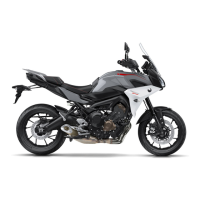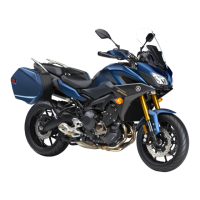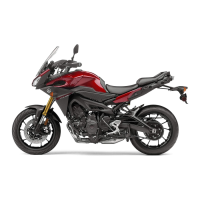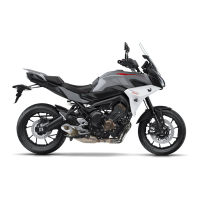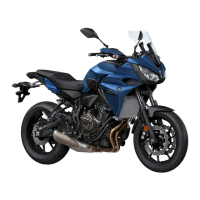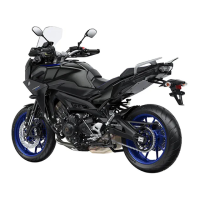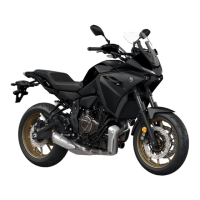Do you have a question about the Yamaha TRACER MTT850 and is the answer not in the manual?
Explains symbols and text conventions for important information.
Owner's responsibility for safe operation and adherence to manual guidelines.
Pre-operation checks, riding posture, and awareness of other motorists.
Importance of helmets, face shields, jackets, boots, gloves for injury prevention.
Dangers of carbon monoxide from exhaust and precautions to avoid it.
Guidelines for adding accessories/cargo to maintain stability and avoid accidents.
Importance of using genuine parts for safety and performance.
Risks associated with aftermarket parts and guidelines for installation.
Instructions for securely transporting the motorcycle to prevent damage and accidents.
Identifies major components visible from the left side of the motorcycle.
Identifies major components visible from the right side of the motorcycle.
Identifies handlebar controls, levers, and instrument panel components.
Details the vehicle's anti-theft system, keys, and indicator light.
Explains the functions of the ignition switch and steering lock positions.
Explains the various indicator and warning lights on the instrument panel.
Details the features and components of the digital instrument display.
Explains the electronically controlled engine performance system with STD, A, and B modes.
Identifies and explains the function of left and right handlebar controls.
Location and operation of the clutch lever.
Explains front/rear brakes, ABS operation, and warnings.
How the TCS works, indicator lights, and settings.
Checks for fuel level, line leakage, and overflow hose.
Checks for oil level and leakage.
Checks for coolant level and system leakage.
Checks brake operation, pads, fluid level, and system for leaks.
Checks clutch operation, cables, and throttle grip.
Checks drive chain, wheels, and tires for condition and pressure.
Procedure for starting the engine with safety checks.
How to shift gears and find neutral for smooth operation.
Procedure for smooth deceleration and proper braking technique.
Advice on riding style to improve fuel economy.
Crucial period for new engines, RPM limits, and initial service.
Safe parking procedures and precautions to prevent hazards.
General guide to maintenance intervals and importance of dealer service.
Location and purpose of the tool kit provided with the vehicle.
Detailed table for emission control system maintenance tasks.
Table for general checks and lubrication intervals for various components.
How to check spark plugs, gap, and tightening torque for engine performance.
Checking engine oil level and procedure for changing oil and filter.
Checking coolant level, quantity, and procedure for changing coolant.
Importance of tire condition, pressure, and inspection for safety.
Checking brake pads, fluid levels, and related components.
Checking and adjusting drive chain slack and lubrication.
Battery type, connections, charging, and long-term storage procedures.
Location of fuse boxes and procedure for replacing blown fuses.
Charts for diagnosing starting problems and poor engine performance.
Procedure for checking coolant level and diagnosing overheating issues.
Detailed steps for washing and drying the motorcycle, including precautions.
Detailed steps for preparing the vehicle for long-term storage.
Location of VIN, engine serial number, and model label for record keeping.
Explains ECU data storage and privacy policy for collected data.
| Displacement | 847cc |
|---|---|
| Transmission | 6-speed |
| Compression Ratio | 11.5 : 1 |
| Fuel System | Fuel Injection |
| Starter System | Electric |
| Final Drive | Chain |
| Fuel Capacity | 18 liters |
| Bore x Stroke | 78.0 mm x 88.7 mm |
| Frame | Diamond |
| Front Suspension | Telescopic forks |
| Rear Suspension | Swingarm |
| Front Brake | Dual 298mm discs |
| Rear Brake | 245mm disc |
| Front Tire | 120/70-ZR17 |
| Rear Tire | 180/55-ZR17 |
| Tires | 120/70ZR17M/C (58W) (Front), 180/55ZR17M/C (73W) (Rear) |
